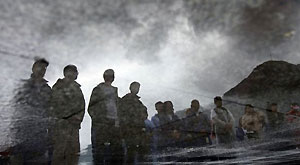China Preserves Ruins of Massive 2008 Quake
Xinhua News Agency, May 10, 2011 Adjust font size:
Rest in peace
Since May 2010, the old town has been opened to the public. But only 1,000 visitors who made reservations beforehand are allowed in per day.
The visitors could express their condolences to the quake victims, which was also a comfort for the victims' families, Zhao said.
Every visitor is charged 12 yuan for the transportation, as they are only allowed to enter the ruins in buses provided by the headquarters.
"We do not sell entrance tickets. Visitors' private cars are not allowed in for the sake of the solemnity and order in the ruins," Zhao said.
To prevent the deceased from being dishonored, the headquarters workers established one-meter-high fences to keep visitors away from the ruins and notice signs to remind the visitors to behave themselves.
Words such as "Our loved ones are sleeping, please keep quiet" are written in Chinese, English, Korean and Japanese.
The headquarters had transformed the newly-built river dikes into roads, which would enable vehicles to bypass the cemetery, which was located by the main road of the old town, Zhao said.
"Now, many vehicles still have to pass the main road that leads to a dozen townships in Beichuan," he said.
In the Donghekou Quake Relics Park in Qingchuan County, which is about three hours' drive from Beichuan, dozens of cross-shaped signs are inserted on several small hills.
More than 780 quake victims of Donghekou Village were buried about 110 meters underneath the signs.
"Their homes were, in a flash, blanketed by the rocks," said He Xiantong, a Donghekou villager who lost 12 family members in the quake. He runs a small shop at the entrance of the park to make ends meet.
The sign, called "Chuandou", is part of the framework of the traditional local residential houses.
"Chuandou marks where families are buried. The signs will make the deceased feel the warmth of homes," He said.


